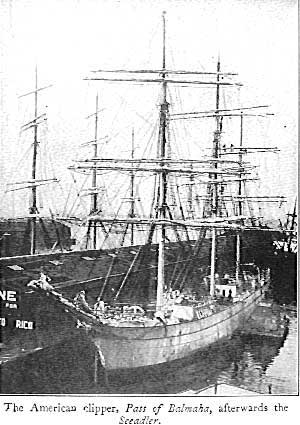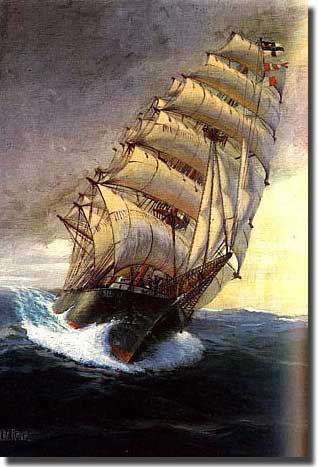|
Letters
Pass of Bahmaha became Seeadler Hello Mac, It is a great site and I can understand the interest in Von Luckner, My father actually has a boat called Seeadler named after Von Luckners boat and has collected a lot of memorabillia and information about him and it. There is even a small model of the man in uniform smoking his pipe on display in the cabin. I am very interested to know if there are any drawings or photos of the original Seeadler and the modifications that they made to it. As we understand there were lots of disgusied and hidden munitions. Appreciate your asistance
Thanks for your note, yet one more comment about von Luckner, my Web Master, Terry Kearns in Atlanta Georgia looks after AHOY, and puts up all my resarch and writing as a result. We are continually suprised interest in the Count from around the world. Nice to hear from you. Here is a picture of Pass of Bahmaha before she was converted to Seeadler. She had been built in 1878 by Robert Dunn and Co at Glasgow. A steel hulled ship, 245 feet long by almost 39 foot beam drawing close to 22 feet. Her GRT 1,571 tons. Speed under sail up to 12 knots dependent upon the wind, with her auxiliary engine 9 knots.
On the 3rd. of August 1915 she was captured by U-Boat 36, and sent off to Cuxhaven in charge of a Midshipman. Renamed Walter, sent to Geestemende and rebuilt for a role as an Armed Merchant Raider. Two 8.8 cm guns added behind hinged gunwhales at the break immediately behind the forecastle, one to port, one to starboard, plus machine guns and some small arms. I have seen a report that two torpedo tubes were added, but not so. A powerful wireless transmitter was also installed. The hold was converted into a prison area to hold up o 400 prisoners, with rows of bunks made from canvas and steel pipe. Special quarters aft were added to house captured ship Captains. The after saloon was mounted on a hydraulic lift, at the touch of a button behind the barometer in the Chart Room, the floor or decking of the saloon was lowered into the deck. The object to capture any unwanted guests given favourable circumstances. A 900bhp four cylinder two stroke diesel unit was acquired from Usines Carels Freres SA of Ghent in Belgium, and fuel tanks were added to store the diesel to supply this engine. The vessel was purporting to be a Norwegian full rigger, she was painted the same colours as Maleta. Pictures of the King and Queen of Norway were hung in the Captain's cabin, the barometer, thermometer and chronometer all of Norwegian make. Registration papers were forged, and several Norwegian speaking German sailors were on board. A sailor played the role of von Luckner's wife. When about to sail, it was realised that the real Maleta had sailed from Denmark, these preparations in vain. The name Hero was selected, the false papers and log book deliberately water damaged to fool any British examiners they may meet. On the 21st. of December 1916 they sailed from the River Weser, and by the 23rd. were in the midst of a wild storm, this added credence to the water damaged documents. On Christmas day, the British Merchant Cruiser Avenger stopped them and sent a boarding party to inspect, but their disguise held up to scrutiny. The deck had been covered with lumber, this disgarded overboard, and the ship became a smart German Armed Raider, Seeadler. The remainder of her career is on the record. Steve, I trust these few notes help a little. Regards,
Seeadler in full cry!
Regards, |


